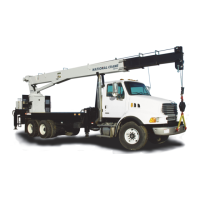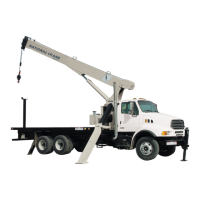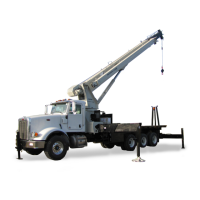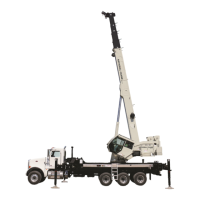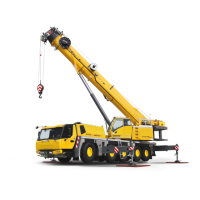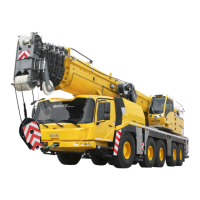2-12
2+ !
The winch is mounted at the rear of the first section
boom. It has capacities totally independent of the rest
of the crane and can normally pull more than the crane
itself can withstand. Therefore, care must be taken to
insure that the load being lifted is within boom rating.
To lift some of the heavier loads on the capacity chart, it
will be necessary to multiple part reeve the winch block
to increase the lifting capacity of the winch (the speed is
proportionately slower) and remain in the strength limi-
tations of the winch and wire rope.
On a crane equipped with an LMI system, the maxi-
mum allowable load indicated on the LMI display, when
a single part of line is selected, will exceed the maxi-
mum pull value listed on the parts of line chart provided
on the crane’s capacity chart. The higher maximum
allowable load is provided to allow full winch perfor-
mance, to the stated single part of line maximum pull
value provided on the crane’s capacity chart, without
the LMI system activating the kick-out function.
#
3$%$&$K%$&6K6'6'#'$%
$&? $)&$3$&$3
#%8
"!
The winch load rating chart on each machine pro-
vides the information for pull limitations on the winch
with various applicable part reevings. These ratings are
based on providing the proper operating safety factor
on the wire rope supplied with the machine. Therefore,
any replacement rope must meet the rope specification
sections of this manual (Figure 1).
"2+"2+
1. Always operate the winch control to payout the
loadline while extending the boom. This will main-
tain clearance between the boom tip and loadline
hook.
2. Do not rely on anti-two-block system to eliminate
two blocking. Use the system as a backup to safe
operation.
3. Make certain the winch cable is not twisted or kinked
and that cable is properly seated on the drum and
in the sheaves.
4. Before lifting a load, always make certain that three
full wraps of rope will remain on the drum at all times
throughout the lift.
5. When lifting a load approaching the rated winch load,
raise the load a few inches and return the control to
neutral to determine if the brake is working prop-
erly.
6. Do not drag loads in any direction with the winch
7. Never attempt to lift loads which are not loose and
free, i.e. frozen down material or poles out of ground.
8. Maintain tension on the loadline at all times to pre-
vent the cable from becoming twisted or kinked or
improperly seated on the winch drum or sheaves.
"+
After the vehicle and crane have been properly set
up and it has been determined the load to be lifted is
within the ratings of the crane and winch reeving sys-
tem, again check the work area for electric power lines
and other obstructions so that proper clearances can
be maintained. (See Safety Rules.) If load is not visible
to operator throughout lift, a person must be appointed
to use hand signals as shown on the last page of this
section. Proceed with lifting the load.
1. Rotate, extend or move up or down until boom
tip is directly over the load.
2. The crane is normally equipped with a rotation
stop. It is important that you be aware of the
position of the stop before lifting in order to as-
sure maximum rotation and prevent excessive
handling of the load.
3. During operations, the controls should always be
metered when beginning or terminating move-
ment to prevent sudden starting or stopping,
which imposes undue shock loads on the equip-
ment. This is especially true when handling
X
MAX. PULL
7,700 lb
(3492 kg)
[Z \ ] _
MAX. PULL
15,400 lb
(6985 kg)
MAX. PULL
23,100 lb
(10 477 kg)
MAX. PULL
30,800 lb
(13 970 kg)
MAX. PULL
38,500 lb
(17 463 kg)
MAX. PULL
46,200 lb
(20 955 kg)
q
MAX. PULL
52,000 lb
(23 586 kg)
"X
Reference Only
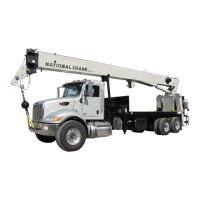
